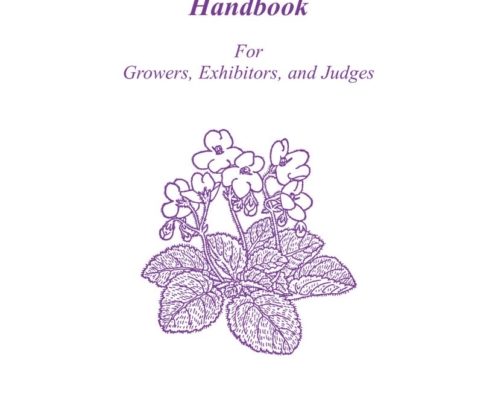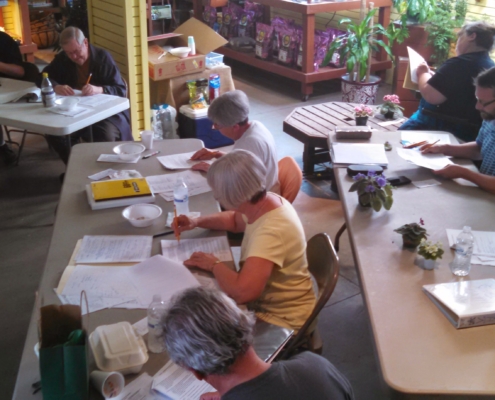A Beginner’s Guide to Judging
Written by Joyce and Kent Stork
Published in the African Violet Magazine May/June 1993
Reviewed/Edited March 2020 by Joyce Stork
Do you grow blue-ribbon violets? In other words, are your violets near the level of perfection expected according to the standards set by the African Violet Society of America? A near-perfect violet is a challenge!
Can these standards help you grow better violets? Yes! When you evaluate your own violets against the standards used for judging show violets, you can work to improve your horticultural shortcomings and grow better, healthier plants – even if you never enter a show.
THE AVSA SCALE OF POINTS
In 1950, AVSA first developed a scale of points for judges’ use in evaluating all aspects of a specimen plant. Through the years, this has evolved to the scale of points used for judging single crown exhibits today:
-
- 25 Points Symmetry or leaf pattern
- 25 Points Condition (cultural perfection)
- 25 Points Quantity of bloom
- 15 Points Size and type of Blossom
- 10 Points Color of Blossom
Presumably, only a perfect violet could ever receive 100 points. The perfect violet is a very rare item! Do notice that there are no points for extreme size. A perfect violet could be less than 6 inches across; it could be 12 inches across; it could be 24 inches across.
So, choose your best violet, and judge it!
SYMMETRY
Beautiful foliage patterns greatly enhance the overall appearance of an African violet. The goal is to grow a plant whose leaves lay in precise overlapping rows. There must not be any apparent leaves missing in any row, and there should not be spaces or gaps between the leaves.
A perfect violet would have a round overall shape and grow horizontally – or flat – without leaves reaching upward. All leaves in a row would be the same size. Center-most leaves in the crown would be smaller, and each succeeding row of leaves would be slightly larger. The petioles (stems) of leaves would be consistently longer in each succeeding row, but not so much longer that gaps are noticeable between the leaves.
Achieving perfect symmetry is not always easy. Violets are individuals. Each variety has a tendency toward a type of foliage pattern. Some varieties do not consistently form a good over-lapping foliage pattern.
Aside from the differences between varieties, it is common for a hybrid to include a few clones which excel. When top show growers select young plants to work on, they look for symmetry. They want to see a pattern of the youngest leaves in the inner three rows forming a compact rosette. Perfection begins there.
A symmetrical violet will do much of the work in growing out symmetrically, but the grower has some responsibility too. Care must be taken to give the plant enough space to avoid breaking leaves from crowding, bumping, or falling. Maintaining even and constant horticulture is also critical. The plant should enjoy regular fertilizer, water, light and consistent temperature. Quality light, from directly overhead, will significantly improve symmetry – this often requires supplementary light.
To judge the symmetry of your plant, begin with 25 points and take off up to three points each for gaps between leaves (1 point for little gaps, 3 for obvious large gaps.) Also deduct for visible changes in the growth pattern and for each leaf that is obviously missing.
How many points did you get for symmetry? Could you improve that score immediately by removing a leaf or even a row or two of leaves?
CONDITION
Condition, or cultural perfection, describes the quality of care given. Imperfections in culture are evident in the appearance of the plant.
Some of these are easily remedied in a few minutes. For example, one can easily remove dust or debris on the leaves by blowing or with a soft-bristle make-up brush. Plants may even be washed under a very gentle flow of tepid water, being careful to keep water away from the center crown and blotting the leaf surface dry afterward. (Keep wet plants out of direct sunlight until the moisture has evaporated.)
Some faults may be removed. The stubs of old leaves and bud stems may be removed with a dull pencil point, a nut pick, or even a dentist’s cleaning tool. Along these same lines, any dead or fading flowers and any flowers with seed pods should be removed.
Damaged leaves may need to be removed because of nicks or spots. Often the oldest leaves are under-sized and found growing under the other bigger leaves. At the same time, remove any leaves that are faded or tired looking. But don’t forget symmetry as you groom! A deduction for a spot is less than the deduction for a gap.
Show violets should be in a pot which is in good proportion to the foliage. A general rule is that the pot should be one-third the diameter of the leaf span. No rules govern the depth of the pot.
A neck between the bottom row of leaves and the soil is ugly evidence that older leaves were removed. Good growers repot often, trimming away enough from the bottom of the soil ball to sink the plant lower into the same pot so that necks are not visible.
To judge condition, begin with 25 points. Take off a half point for each faded blossom. Take off up to a point for each occurrence of dust or debris, each stub, and each seed pod. Also take off a point for under-sized or faded leaves. Take off up to three points for over- or under-potting and the same for a neck. Take off up to a point for each crack, mar or bruise.
How many points do you score for condition? Could you improve by cleaning, by removing stubs, flowers and leaves, or by repotting?
QUANTITY OF BLOOM
The amount of bloom on the violet Is important in judging. One of the most difficult skills for a judge to master is evaluating how many blossoms ought to be open on the plant. Large plants need to have more actual flowers than tiny plant.
To simplify the judging, The AVSA Handbook for African. Violet Growers, Exhibitors and Judges suggests that the judges should decide how many fresh open blossoms should be expected on a violet of a given size when it is in full bloom and deduct points proportionately.
Judges might reasonably expect a 12” diameter – a standard violet – to have 5 flower stalks with 5 open flowers. A violet which is only 6” in diameter – a miniature violet – might only be expected to have 3 flower stalks with 3 open flowers.
African violets may be disbudded to control exactly when they bloom, so it is not difficult to have the maximum number of blossoms open exactly at showtime. The book Growing to Show written by Pauline Bartholomew (and sold by the African Violet Society of America) is recommended to growers who want to master the art of disbudding.
To judge your plant for quantity of bloom, begin with 25 points. Look at one flower stalk on your plant and count how many flowers could reasonably be open at one time. How many flowers would it be reasonable to expect if three to five flower stalks were present? For example: If you expect 15 open fresh flowers and you have only 9 flowers present, use this formula to find the points: divide 9 by 15 and multiply the answer by 25 to get a score of 15 points.
How many points do you score for bloom? You might try disbudding to see if you could increase this score on another day.
SIZE AND TYPE OF BLOOM
Now we get into the points allowed for a plant performing according to its official description. Each plant variety’s DNA determines the size and type of its flowers.
Experienced judges can quickly recognize under-sized flowers and will deduct points. If the cultivar description states “large flowers” judges will expect more. The size of all open flowers should be consistent.
By type, we mean both the number of layers of petals – single, semidouble, or double – and the shape of the blossom – pansy, star, wasp, ruffled, etc. If there are blossoms on the plant which are not a good match to the official description of the variety, it is a fault, and points should be deducted.
How can you know these things? AVSA publishes a Master Variety List (also known as First Class in the software version) which describes many of the varieties currently being cultivated. In addition, good judges try to grow many plants to get experience, frequently visit shows, and speak with other growers about their favorite violet varieties.
Without those tools, you can’t deduct points reliably. For today, do not deduct points here unless the blossoms are inconsistent in size or type. In most cases you will receive all 15 points on size and type of blossom. If you decide to enter a show, you must have it properly named so that the Classification Chairman may verify that the plant is blooming true.
COLOR OF BLOSSOM
The blossom color must conform to the description in the Master Variety List. It must first be the color described but also must not be faded or lack the intensity of color expected. Very warm temperatures, poor light, or poor fertilization may cause flowers to lack intensity. Occasionally, varieties will show signs that they are mutating (or sporting) by putting up a blossom stem which is entirely different from the other blossoms on the plant. This is especially true of bi-color plants and fantasies (blossoms that are speckled). This is a fault which costs one-half point per wrong-color blossom.
To judge color, begin with 10 points. Deduct a half point for each flower which is inconsistent. If you know it is not blooming true, take off all 10 points.
UNFORGIVABLE SHOW FAULTS
Before we add up your score, take another look at your plant. If it has evidence of insects or disease, it would not be allowed in the show. This protects other exhibitors’ plants from being exposed to such problems.
You also may not enter if your violet is supposed to have one crown but instead has suckers or secondary plants growing between the leaves. Except for trailing types, violets that are judged must be single crowned! If suckers are removed when only four leaves are evident, they can be easily controlled. It Is best to keep a close eye on your plants and to remove small suckers promptly.
YOU’RE A WINNER
Now total the score for each of the five areas. If your total score is above 90 points, your plant deserves a blue ribbon. If it scores from 80 to 89, it will earn a red ribbon; and 70 to 79 points will score a white ribbon. Below 70 points earns no award.
You may tend to be overly critical (most novice judges are). AVSA judges work in panels of three at shows, which helps them to make balanced and kinder decisions.
If you followed our suggestions, you probably noticed that as you fixed some of the correctable problems to increase your score, you also got a prettier plant. Judging by AVSA standards will raise your expectations of your plants, and higher standards result in higher quality.
This judging primer might encourage you to enter a violet show or to attend an AVSA Judging School. Good growers produce excellent exhibits and often make fine judges.
Do not worry if your violet didn’t score high today. Set your goal to improve your culture, and watch your violet raise its score next time.





